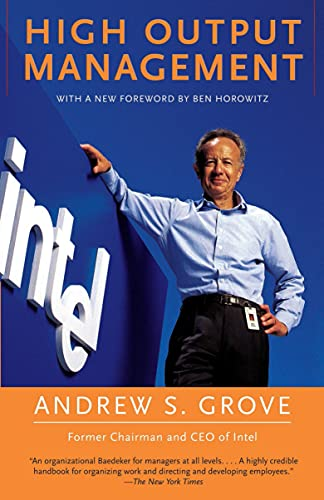- Tags:: 📚Books, Engineering Management
- Author:: Andrew S. Grove (CEO of Intel)
- Liked:: 4
- Link:: High Output Management a book by Andrew S. Grove (bookshop.org)
- Source date:: 1995-08-29
- Finished date:: 2022-02-19
- Cover::

Let chaos reign, then rein in chaos.
…anything that can be done will be done, if not by you, then by someone else (…) as a manager in such workplace, you need to develop a higher tolerance for disorder. Now, you should still not accept disorder. In fact, you should do your best to drive what’s around you to order (p. XIV).
Pero… por favor, stop libros de management enfocando esto como si fuera la milicia.
On competition
Regarding establishing metrics, the author says:
…they give us a measure by which various administrative groups performing the same function in different organizations can be compared with each other. Ther performance of a custodial group in one major building can now be compared with that of another group in a second building. In fact, if indicators are put in place, the competitive spirit engendered frequently has an electrifying effect on the motivation each group brings to its work, along with a parallel improvement in performance (p. 18-19).
…endow work with the characteristics of competitive sports. And the best way to get that spirit into the workplace is to establish some rules of the game and ways for employees to measure themselves. Eliciting peak performance means going up against something or somebody. (…)This is key to the manager’s approach and involvement: he has to see the work as it is seen by the people who do that work every day and then create indicators so that his subordinates can watch their “racetrack” take shape. (p. 170)
Team of Teams
Hybrid organizations
Good management rests on a reconciliation of centralization and decentralization (p. 123).
Centralization means function-oriented teams (e.g., a centralized data team), and decentralization means mission-oriented teams (i.e., multidisciplinar teams, your typical Spotify squad). However, there is a trade-off. Mission-oriented teams main advantage is:
- Easier to be outcome-oriented:
…can stay in touch with the needs of their business or product areas and initiate changes rapidly when those needs change. (p. 126)
- Prioritization is easy (only taking into account a domain). However:
- They lack flexible allocation, as opposed to centralized teams:
…resources can be shifted and reallocated to respond to changes in corporate-wide priorities (p. 125).
- Duplicated efforts.
- No shared expertise in specific trades.
The “ideal” way to reconcile this for Andrew Grove is Matrix organization, which is hard but inevitable. And this is clearly related to Data team topologies (as well as other engineering types: embedded in mission teams, but also part of a functional chapter):
Here I would like to propose Grove’s Law: all large organizations with a common business purpose end up in a hybrid organizational form. (p. 126)
The use of the hybrid organizational form does not even necessarily depend on how large a business or activity is. (p. 128)
Matrix management is a complicated affair. (p. 131)
It’s not because Intel loved ambiguity that we became a hybrid organization. We have tried everything else, and while other models may have been less ambiguous, they simply didn’t work (p. 136) (Uncertainty).
Matrix organization was created unintentionally by the Nasa to land on the moon! (p. 131).
These arrangements may not be fixed:
… a single organization may very well shift back and forth between the two poles, movement that should be brought on by pragmatic considerations (…) But the most important consideration should be this: the shift back and forth between the two types of organizations can and should be initiated to match the operational styles and aptitudes of the managers running the individual units. (p. 129)
And… another shit to management (✍️ Déjame sin trabajo, por favor):
… the answer lies with the middle managers. Within a company, they are, in the first place, numerous enough to cover the entire range of operation; and, in the second place, very close to the problem we’re talking about—namely, generating internal resources and consuming those resources. (p. 130)
Dual reporting

In order to support a mission-oriented team manager, people report also to another function-oriented manager with a technical supervisory relationship:
We found ourselves asking, “A person has to have a boss, so who is in charge here? Could an employee in fact have two bosses? The answer was a tentative “yes,” and the culture of join reporting relationships, dual reporting, was born. (p. 133)
Note that he also contemplates the possibility that the technical supervision comes from the chapter (the peer group), without a functional manager.
Andrew carries this idea further, to also include transitory teams (Task forces).